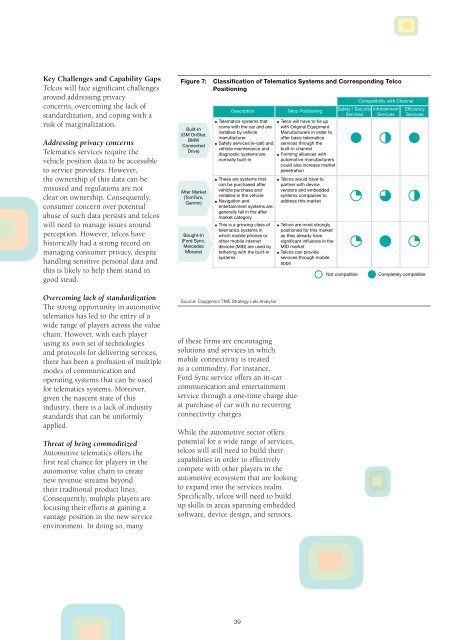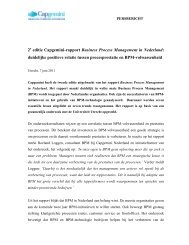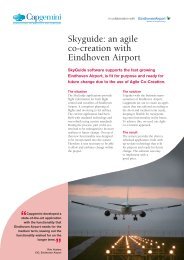IT transformations - Capgemini Consulting Nederland
IT transformations - Capgemini Consulting Nederland
IT transformations - Capgemini Consulting Nederland
Create successful ePaper yourself
Turn your PDF publications into a flip-book with our unique Google optimized e-Paper software.
Key Challenges and Capability Gaps<br />
Telcos will face significant challenges<br />
around addressing privacy<br />
concerns, overcoming the lack of<br />
standardization, and coping with a<br />
risk of marginalization.<br />
Addressing privacy concerns<br />
Telematics services require the<br />
vehicle position data to be accessible<br />
to service providers. However,<br />
the ownership of this data can be<br />
misused and regulations are not<br />
clear on ownership. Consequently,<br />
consumer concern over potential<br />
abuse of such data persists and telcos<br />
will need to manage issues around<br />
perception. However, telcos have<br />
historically had a strong record on<br />
managing consumer privacy, despite<br />
handling sensitive personal data and<br />
this is likely to help them stand in<br />
good stead.<br />
Figure 7:<br />
Built-In<br />
(GM OnStar,<br />
BMW<br />
Connected<br />
Drive)<br />
After Market<br />
(TomTom,<br />
Garmin)<br />
Bought-In<br />
(Ford Sync,<br />
Mercedes<br />
Mbrace)<br />
Classification of Telematics Systems and Corresponding Telco<br />
Positioning<br />
Description<br />
■ Telematics systems that<br />
come with the car and are<br />
installed by vehicle<br />
manufacturer<br />
■ Safety services (e-call) and<br />
vehicle maintenance and<br />
diagnostic systems are<br />
normally built-in<br />
■ These are systems that<br />
can be purchased after<br />
vehicle purchase and<br />
installed in the vehicle<br />
■ Navigation and<br />
entertainment systems are<br />
generally fall in the after<br />
market category<br />
■ This is a growing class of<br />
telematics systems in<br />
which mobile phones or<br />
other mobile internet<br />
devices (MID) are used by<br />
tethering with the built-in<br />
systems<br />
Telco Positioning<br />
Safety / Security<br />
Services<br />
■ Telco will have to tie up<br />
with Original Equipment<br />
Manufacturers in order to<br />
offer basic telematics<br />
services through the<br />
built-in channel<br />
■ Forming alliances with<br />
automotive manufacturers<br />
could also increase market<br />
penetration<br />
■ Telcos would have to<br />
partner with device<br />
vendors and embedded<br />
systems companies to<br />
address this market<br />
■ Telcos are most strongly<br />
positioned for this market<br />
as they already have<br />
significant influence in the<br />
MID market<br />
■ Telcos can provide<br />
services through mobile<br />
apps<br />
Not compatible<br />
Compatibility with Channel<br />
Infotainment<br />
Services<br />
Efficiency<br />
Services<br />
Completely compatible<br />
Overcoming lack of standardization<br />
The strong opportunity in automotive<br />
telematics has led to the entry of a<br />
wide range of players across the value<br />
chain. However, with each player<br />
using its own set of technologies<br />
and protocols for delivering services,<br />
there has been a profusion of multiple<br />
modes of communication and<br />
operating systems that can be used<br />
for telematics systems. Moreover,<br />
given the nascent state of this<br />
industry, there is a lack of industry<br />
standards that can be uniformly<br />
applied.<br />
Threat of being commoditized<br />
Automotive telematics offers the<br />
first real chance for players in the<br />
automotive value chain to create<br />
new revenue streams beyond<br />
their traditional product lines.<br />
Consequently, multiple players are<br />
focusing their efforts at gaining a<br />
vantage position in the new service<br />
environment. In doing so, many<br />
Source: <strong>Capgemini</strong> TME Strategy Lab Analysis<br />
of these firms are encouraging<br />
solutions and services in which<br />
mobile connectivity is treated<br />
as a commodity. For instance,<br />
Ford Sync service offers an in-car<br />
communication and entertainment<br />
service through a one-time charge due<br />
at purchase of car with no recurring<br />
connectivity charges.<br />
While the automotive sector offers<br />
potential for a wide range of services,<br />
telcos will still need to build their<br />
capabilities in order to effectively<br />
compete with other players in the<br />
automotive ecosystem that are looking<br />
to expand into the services realm.<br />
Specifically, telcos will need to build<br />
up skills in areas spanning embedded<br />
software, device design, and sensors.<br />
39
















